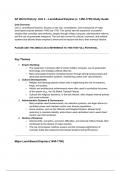AP World History: Unit 3 – Land-Based Empires (c. 1450-1750) Study Guide
Unit Overview:
Unit 3, Land-Based Empires, focuses on the rise, consolidation, and eventual fall of major
land-based empires between 1450 and 1750. This period saw the expansion of powerful
empires that controlled vast territories, largely through military conquest, administrative reforms,
and the use of gunpowder weaponry. The unit also covers the cultural, economic, and political
systems that allowed these empires to thrive and the factors that led to their eventual decline.
PLEASE USE THE AMSCO AS A REFERENCE TO THIS FOR FULL POTENTIAL.
Key Themes
1. Empire Building:
○ The expansion of empires often involved military conquest, use of gunpowder
technology, and strategic political alliances.
○ Many land-based empires centralized power through strong bureaucracies and
advanced administrative systems, maintaining control over vast territories.
2. Cultural Developments:
○ Religion and ideology played critical roles in legitimizing the rule of emperors,
kings, and sultans.
○ Artistic and architectural achievements were often used to symbolize the power
of the empire (e.g., the Taj Mahal, Topkapi Palace).
○ Cultural and religious tolerance, or the lack thereof, often shaped internal policies
and social cohesion.
3. Administrative Systems & Governance:
○ Many empires used bureaucracies, tax collection systems, and legal reforms to
centralize power and maintain control over diverse populations.
○ Some empires, such as the Ottoman and Mughal Empires, allowed local
autonomy to maintain stability, while others used centralized rule to exert direct
control over their territories.
4. Decline of Empires:
○ Internal strife, corruption, economic difficulties, and external military threats often
contributed to the decline of major empires.
○ The rise of European maritime powers and the increased significance of
overseas trade also weakened land-based empires during this period.
Major Land-Based Empires (1450-1750)
, 1. The Ottoman Empire (c. 1299-1922)
● Key Features:
○ Location: Spanned across Southeast Europe, Western Asia, and North Africa,
with its capital in Istanbul (formerly Constantinople).
○ Rise & Expansion: The Ottomans captured Constantinople in 1453, marking the
fall of the Byzantine Empire. They expanded into the Balkans, the Middle East,
and North Africa.
○ Political Structure: Centralized bureaucracy with a sultan at the top. The
Ottoman system was highly organized with the use of viziers and a devshirme
system (where Christian boys were recruited into the military and administrative
elite, known as the Janissaries).
○ Economic Strength: The empire controlled major trade routes between Europe
and Asia, making it wealthy through taxation and control of commerce.
● Cultural & Religious Tolerance:
○ The Ottoman Empire was known for its relatively tolerant approach to religious
diversity. Non-Muslims (Christians, Jews) were allowed to practice their faith
under the millet system, which gave religious communities a degree of autonomy
in exchange for loyalty to the empire.
○ The Ottoman rulers, especially under Suleiman the Magnificent (1520-1566),
supported the arts, architecture, and law, contributing to a cultural golden age.
● Decline:
○ The empire began to decline due to internal corruption, military defeats (e.g.,
Battle of Lepanto, 1571), and the increasing pressure of European maritime
expansion, which bypassed Ottoman-controlled trade routes.
2. The Safavid Empire (c. 1501-1736)
● Key Features:
○ Location: Based in Persia (modern-day Iran), the Safavid Empire was a Shia
Muslim empire that frequently conflicted with its Sunni Ottoman and Mughal
neighbors.
○ Political Structure: Ruled by Shahs who centralized authority and patronized
Shia Islam to differentiate from the Ottomans and legitimize their rule.
○ Religious Policies: The Safavid Empire imposed Shia Islam as the state religion
and persecuted Sunni Muslims and other religious minorities.
○ Economic Strength: The empire controlled key trade routes linking the Middle
East with India and China. He also made allies with European powers.
● Cultural Contributions:
○ Persian art and architecture flourished under Safavid rule, with the development
of distinctively Persian styles in painting, ceramics, and textiles.
○ Isfahan, the capital city, became a center of cultural and intellectual achievement,
exemplified by its impressive mosques and public spaces.
● Decline:




